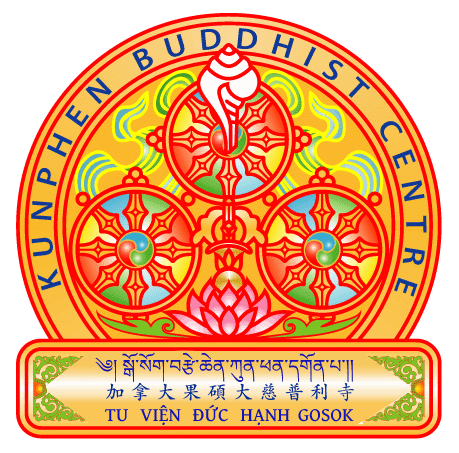怙主果碩仁波切講於2010年4月屏東大威德金剛火供法會
佛陀弘法四十九年期間,曾於初、中、後三個時期分別四次宣說四聖諦的教法—對於苦諦(輪迴中一切的痛苦)要認識它,關於集諦(導致痛苦的原因)要斷除它;對於滅諦(涅槃的究竟安樂)要證悟它,關於道諦(證得涅槃的道路及方法)要修持它。因此佛陀住世弘法期間,共宣說了十二次四聖諦的教法。
佛陀每次宣說四聖諦教法時,均以四種層次宣說,例如宣說集諦時,分為因(觀苦果之因)、集(觀招集苦果)、生(觀苦果生,相繼存在)、緣(觀諸緣成就苦果)四種行相分別講授,由補特伽羅執著有自主的〝我〞(人我與法我二種執著中之人我執。),由此執著導致業與煩惱,由業與煩惱繫縛眾生於輪迴中不斷流轉,因此,業與煩惱是行者需斷除的對象。宣說苦諦時,分為無常(觀因緣假成,故生滅無常)、苦(觀此身是苦)、空(觀因緣所生故空)、無我(觀因緣假成,故無我體)四種行相分別講授。宣說道諦時,分為道(觀八正道,可至涅槃)、如(道契正理,故如)、行(由此萬行,以趣涅槃)、出(由此聖道,以出生死)四種行相分別講授。宣說滅諦時,則分為滅(觀諸漏已盡,生死斷滅)、靜(觀三毒皆無,此心不亂,有明照作用,故靜)、妙(觀出離三界,無諸憂患,故妙)、離(觀一切災害,皆已遠離)四種行相分別講授,合稱為「四諦十六種行相」。此為聲聞乘教法主要之內容與觀修方法,融攝了戒、定、慧三增上學,不只小乘行者以此為修持的依歸,大乘行者亦須修持上述之內容。
聲聞乘的教法中,亦包涵了五道十地(「五道十地」,也就是資糧、加行、見、修與無學等五道,與見白(初見白淨法之道)、種性(種姓無亂從此得故)、八人(阿羅漢為第一至預流向為第八聖)、見(最初現見人無我)、薄(欲貪微薄)、離欲、已辦、獨覺、菩薩地、佛地等十種地位。)的修持方法。就資糧道而言,當聲聞乘行者對輪迴生起不退轉的出離心,即是具備了資糧道的證量。行者生起堅定的出離心之後,藉由持守戒律,獲得三摩地的禪定力(止),在以此定力觀修補特伽羅(補特伽羅(梵文pudgala),意譯為數取趣,泛指通常所說的「有情」、「眾生」,實指輾轉輪迴於六道的主體。)人我空與法我空,進而達到止觀雙運,即具備了加行道之證量。當行者現證人我空的同時,即具備了見道的證量。若行者對於人我空的證量能堅固不斷,即具備了修道的證量,修道的過程可分為預流果、一來果、不還果、阿羅漢果等四種果位(又稱為八向住:四向及四住果,分別為預流向及預流果,一來向及一來果,不還向及不還果,阿羅漢(應供)向及阿羅漢(應供)果。),這四種果位皆是行者對於人我空證量不斷所獲致的結果。行者入於預流果之後即是獲致解脫的聖者,此四種果位可再細分為二十僧伽(《現觀莊嚴論》〈一切相智品〉說:「諸頓根利根,信見至家家,一間中生般,行無行究竟,三超往有頂,壞色貪現法,寂滅及身證,麟喻共二十。」師子賢論師主張此二頌明說的僧衆有:頓根、利根、信解、見至、人家家、天加家、一間、中般、生般、有行般、無行般、全超、半超、遍歿、現法寂滅、身證、麟喻等十七項; 隱說的僧衆有:預流果、一來果、阿羅漢向等三類,共計有「二十僧衆」。)。
阿羅漢由於修習人我空及四諦十六行相已臻究竟,最後可分別證得有餘涅槃及無餘涅槃。阿羅漢雖斷除了一切煩惱與業障,但因蘊體(五蘊和合而成之身體)仍然存在,故稱為有餘涅槃。待蘊體消失之後,僅剩以人我空所證悟之涅槃,即為無餘涅槃。有餘及無餘涅槃皆是由持續不斷的觀修人無我而證悟,行者欲證悟人無我必須認知有漏(煩惱)的蘊體是由業與煩惱感召而得,隨時都可能崩壞,所以是無常而非恆常存在。輪迴中的有情眾生因業與煩惱的牽引而取得蘊體,生命中所經歷的一切現象無非是苦苦、壞苦、行苦(苦苦:生老病死等顯而易見的痛苦;壞苦:變苦,表面看似安樂,本質卻是痛苦的現象;行苦:自出生之後即不斷趨向壞滅,絲毫不能自主的痛苦。)。雖然天人沒有苦苦,而地獄眾生則沒有壞苦,但在三界輪迴中,自最底層的地獄乃至最高的有頂皆無法脫離行苦。所有的有情眾生皆懂得遠離苦苦,部分的眾生明瞭壞苦不值得追求,但對於行苦卻不易察覺與認知,但行苦卻是遍及三界輪迴的痛苦,因此,痛苦乃是輪迴的本質。欲遠離痛苦就必須斷除引發痛苦的原因—業與煩惱,而業與煩惱乃是依附於補特伽羅有自主的我的執著。在大乘教法中,稱此種執著為粗分的我執,欲斷粗分的我執,唯有不斷觀修人無我,證悟人我空,才能斷除業與煩惱,自輪迴的痛苦中解脫。
既然我執是引發輪迴痛苦的根源,因此,行者必須思惟我執是如何產生?我執的狀態為何?我執所執著的對象為何?我執具有哪些過患?我執是一種觀念與認知,所執著的對象即為”我”或”補特伽羅”。佛教各宗對於如何斷除我執,皆有各自的主張,我執可分為二種:一為俱生我執,一為遍計我執,俱生我執是最主要與根本的我執,一切有情眾生都具有的執著,與佛教或外道的宗義無關。遍計我執則是與對於蘊體存在狀態的理解相反,此種我執認為蘊體(肉身)是無常、可分割、依他因而生;但蘊體之外卻有恆常獨立存在且不可分割的”我”,執著我具有常、一、自主等特性,此即為遍計我執。
俱生我執猶如國王,將蘊體視為任其使喚的奴僕;亦如水手由於熟悉大海,故將大海視為任其統御的領域一般。此種執著認為有常、一、自主的我,對於我的認知並非僅止於認定我是名言或概念上安立,是相對及依他起的;而是執著我是恆常自主獨立存在的實體。此種對我的概念與認知屬於宗義所提及〝遮〞與〝成〞二者中之〝遮〞(意指否定、破除,分為遮(否定)、能遮(能否定)、所遮(被否定)等三者。)。了解我執的對象與狀態之後,行者在修學的過程中,經由破除執著我是常、一、自主等錯誤概念與認知,會產生空的見解;當對空生起定解之後,進而必須不斷的串習空性,此為行者必經的修行之路。
關於如何破除(遮)我執,在宗義中有各種不同的見解。若依法稱論師的見解:由我是自主及我是自性有此二種層面來破除我執,由我是自性有的概念會引生我是一或多的邏輯論證。我執並不存在於外界而是存在於行者內心中的見解或概念,當我們想起〝我〞時,內心呈現何種見解與感受,我們必須加以分析。由建立我空的概念,可以有許多方法來對治我執。若是俱生我執所執著的〝我〞是真實且有自性的存在,則會有二種可能:一者我與五蘊身(蘊體)是不可分離的相同存在,二者我與五蘊身是可分離的不同存在,除此之外,別無其他可能。若我與五蘊身是相同的存在,則當我是獨立自主且有自性的存在時,五蘊身也必然是獨立自主且有自性的存在,我與五蘊身是無二無別且具有相同自性,不可能出現我是獨立自主的存在而五蘊身卻不是獨立自主存在的結果。然而,一旦五蘊身是獨立自主的存在,則五蘊身即成為無因生,不需觀待因緣而能獨立自主存在,離開相對而進入絕對的範疇。如此,則與之前所述,五蘊身屬於苦諦,具有無常的特質,是煩惱與業所感召的結果相違背。因此,五蘊身不可能是獨立自主的存在,我與五蘊身是無二無別(是一非多)的論點即無法成立。
既然我與五蘊身非一,則是否可以成立二者是相離的不同存在(是多非一)呢?若我與五蘊身相離,由於五蘊身是由色、受、想、行、識等五蘊所組成,五蘊尚可再加以細分,如此,則原應是常、一、自主的我,也具有多種不同的特質與屬性。依此種認知,五蘊各自分離壞滅之後,仍會有獨立的我存在;若我無須依賴蘊身,則可以獨自存在於花草樹木、岩石山林等任何形體之中,此種論點與事實不符,故無法成立。既然我與五蘊身非一亦非多,所以能證成我並非獨立自主的真實存在。此種無我的認知屬於粗分的無我,行者由了知我執的錯誤及存在的狀態,知道斷除我執的方法,依此次第當能漸次契入斷除細分我執的修持,如此循序漸進才能對行者產生真正的助益。否則,若略過對治粗分無我的修持,而由細分的無我–如中觀應成派所主張的諸法無自性等教法開始修學,則可能僅止於聽聞而無法理解,更不易對修行有真正的助益。猶如學生必須由基礎的字母拼音學起,再漸次學習較為艱深的學問一般。
以上所述是關於聲聞乘修學道次第的概述,若就菩提道次第廣論而言,屬於下士道及中士道的修持方法,是聲聞乘與大乘佛教共通的修持方法。但行者若基於利益一切眾生的菩提心而修持下士道及中士道,由於菩提心是以”為利眾生願成佛”為目標,以此發心修持聲聞乘的道次第即能成為大乘菩提道的不共修法。我們都是大乘佛教徒,所有的修學次第皆以大乘的五道十地而建立,對於聲聞乘的五道十地則較少提及,相關的著作也較為少見。因而於此對聲聞乘的道次第做簡略的論述,希望能對諸位的修學有所幫助。
http://www.kunphen.com/html/2010/gljy_0914/112.html


